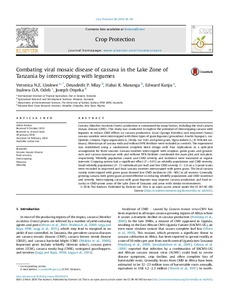| dc.contributor.author | Uzokwe, Veronica N.E. |
| dc.contributor.author | Mlay, D.P. |
| dc.contributor.author | Masunga, H.R. |
| dc.contributor.author | Kanju, E. |
| dc.contributor.author | Odeh, I. O. |
| dc.contributor.author | Onyeka, J. |
| dc.date.accessioned | 2019-12-04T10:57:31Z |
| dc.date.available | 2019-12-04T10:57:31Z |
| dc.date.issued | 2016-06 |
| dc.identifier.citation | Uzokwe, V. N., Mlay, D. P., Masunga, H. R., Kanju, E., Odeh, I. O. & Onyeka, J. (2016). Combating viral mosaic disease of cassava in the Lake Zone of Tanzania by intercropping with legumes. Crop Protection, 84, 69-80 |
| dc.identifier.issn | 0261-2194 |
| dc.identifier.uri | https://hdl.handle.net/20.500.12478/766 |
| dc.description.abstract | Cassava (Manihot esculenta Crantz) production is constrained by many factors, including the viral cassava mosaic disease (CMD). This study was conducted to explore the potential of intercropping cassava with legumes to reduce CMD effects on cassava production. Local (Lyongo Kwimba) and improved (Suma) cassava varieties were intercropped with three types of grain legumes (groundnut, Arachis hypogea L. var. Upendo; cowpea, Vigna unguiculata (L.) Walp. var. Vuli; and green gram, Vigna radiata (L.) R. Wilczek var. Imara). Monocrops of cassava with and without NPK fertilizer were included as controls. The experiment was established using a randomized complete block design with four replications in a split-plot arrangement for three seasons. Cassava varieties intercropped with cowpeas, green gram, and groundnuts and cassava monocrops with and without NPK fertilizer constituted the main plot and sub-plots, respectively. Whitefly population counts and CMD severity and incidence were measured at regular intervals. Cropping system had a significant effect (P < 0.05) on whitefly populations and CMD severity. Small whitefly populations (0–7.5 individuals per leaf) and low CMD severity (1–2.4 on a 5-point scale) were recorded in improved and local cassava varieties intercropped with green gram. The local cassava variety intercropped with green gram showed low CMD incidences (0%–40%) in all seasons. Generally, growing cassava with green gram proved effective in reducing whitefly populations and CMD incidence and severity. Intercropping cassava with grain legumes may improve cassava production and food security in CMD-prone areas of the Lake Zone of Tanzania and areas with similar environments. |
| dc.format.extent | 69-80 |
| dc.language.iso | en |
| dc.subject | African Cassava Mosaic Virus |
| dc.subject | Food Security |
| dc.subject | Intercropping |
| dc.title | Combating viral mosaic disease of cassava in the Lake Zone of Tanzania by intercropping with legumes |
| dc.type | Journal Article |
| dc.description.version | Peer Review |
| cg.contributor.crp | Roots, Tubers and Bananas |
| cg.contributor.crp | Grain Legumes |
| cg.contributor.affiliation | International Institute of Tropical Agriculture |
| cg.contributor.affiliation | Agricultural Research and Development Institute, Tanzania |
| cg.contributor.affiliation | National Root Crops Research Institute, Nigeria |
| cg.contributor.affiliation | University of Sydney |
| cg.coverage.region | Africa |
| cg.coverage.region | East Africa |
| cg.coverage.country | Tanzania |
| cg.isijournal | ISI Journal |
| cg.authorship.types | CGIAR and developing country institute |
| cg.iitasubject | Cassava |
| cg.iitasubject | Cowpea |
| cg.journal | Crop Protection |
| cg.howpublished | Formally Published |
| cg.accessibilitystatus | Open Access |
| local.dspaceid | 74404 |
| cg.targetaudience | Scientists |
| cg.identifier.doi | https://dx.doi.org/10.1016/j.cropro.2016.02.013 |

